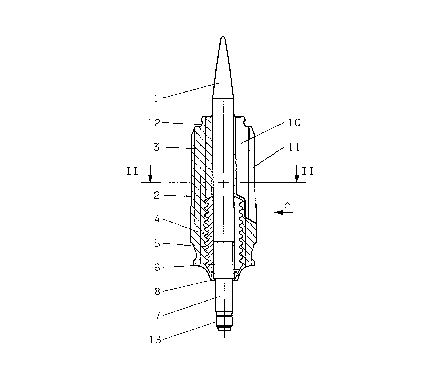Some of the information on this Web page has been provided by external sources. The Government of Canada is not responsible for the accuracy, reliability or currency of the information supplied by external sources. Users wishing to rely upon this information should consult directly with the source of the information. Content provided by external sources is not subject to official languages, privacy and accessibility requirements.
Any discrepancies in the text and image of the Claims and Abstract are due to differing posting times. Text of the Claims and Abstract are posted:
| (12) Patent: | (11) CA 2215295 |
|---|---|
| (54) English Title: | SABOT FOR A SUBCALIBER PROJECTILE |
| (54) French Title: | SABOT DE PROJECTILE SOUS-CALIBRE |
| Status: | Expired and beyond the Period of Reversal |
| (51) International Patent Classification (IPC): |
|
|---|---|
| (72) Inventors : |
|
| (73) Owners : |
|
| (71) Applicants : |
|
| (74) Agent: | MACRAE & CO. |
| (74) Associate agent: | |
| (45) Issued: | 2000-08-22 |
| (22) Filed Date: | 1997-09-11 |
| (41) Open to Public Inspection: | 1998-07-27 |
| Examination requested: | 1997-09-11 |
| Availability of licence: | N/A |
| Dedicated to the Public: | N/A |
| (25) Language of filing: | English |
| Patent Cooperation Treaty (PCT): | No |
|---|
| (30) Application Priority Data: | ||||||
|---|---|---|---|---|---|---|
|
This sabot results in an optimal gas seal and reduction
in the weight and the risk posed by the formation of metal
splinters. For this purpose, the sabot body (4) is completely
enclosed by the sabot casing (3) which partly also encloses
the rear of the pointed projectile (1). The sabot body (4)
has the shape of a one-part or multiple-part hollow body with
circumferential grooves (5, 34), and an exterior diameter
which is smaller than the diameter of the sabot casing.
(Fig. 1)
Sabot permettant d'obtenir un joint optimal de retenue du gaz et de diminuer le poids et le risque que présente la formation d'éclats de métal. A cette fin, le corps du sabot (4) est totalement entouré d'une douille de sabot (3) qui recouvre en partie l'arrière du projectile (1). Le corps du sabot (4) a la forme d'un corps creux constitué d'une ou de plusieurs pièces; il est muni de rainures sur sa circonférence (5, 34) et a un diamètre extérieur qui est inférieur à celui de la douille du sabot. (Fig. 1)
Note: Claims are shown in the official language in which they were submitted.
Note: Descriptions are shown in the official language in which they were submitted.

2024-08-01:As part of the Next Generation Patents (NGP) transition, the Canadian Patents Database (CPD) now contains a more detailed Event History, which replicates the Event Log of our new back-office solution.
Please note that "Inactive:" events refers to events no longer in use in our new back-office solution.
For a clearer understanding of the status of the application/patent presented on this page, the site Disclaimer , as well as the definitions for Patent , Event History , Maintenance Fee and Payment History should be consulted.
| Description | Date |
|---|---|
| Time Limit for Reversal Expired | 2017-09-11 |
| Letter Sent | 2016-09-12 |
| Grant by Issuance | 2000-08-22 |
| Inactive: Cover page published | 2000-08-21 |
| Inactive: Final fee received | 2000-05-18 |
| Pre-grant | 2000-05-18 |
| Notice of Allowance is Issued | 2000-04-20 |
| Letter Sent | 2000-04-20 |
| 4 | 2000-04-20 |
| Notice of Allowance is Issued | 2000-04-20 |
| Inactive: Approved for allowance (AFA) | 2000-04-03 |
| Amendment Received - Voluntary Amendment | 2000-01-07 |
| Inactive: S.30(2) Rules - Examiner requisition | 1999-08-11 |
| Application Published (Open to Public Inspection) | 1998-07-27 |
| Inactive: IPC assigned | 1998-01-20 |
| Classification Modified | 1998-01-20 |
| Inactive: First IPC assigned | 1998-01-20 |
| Inactive: Filing certificate - RFE (English) | 1997-11-17 |
| Letter Sent | 1997-11-17 |
| Application Received - Regular National | 1997-11-17 |
| Request for Examination Requirements Determined Compliant | 1997-09-11 |
| All Requirements for Examination Determined Compliant | 1997-09-11 |
There is no abandonment history.
The last payment was received on 1999-08-17
Note : If the full payment has not been received on or before the date indicated, a further fee may be required which may be one of the following
Patent fees are adjusted on the 1st of January every year. The amounts above are the current amounts if received by December 31 of the current year.
Please refer to the CIPO
Patent Fees
web page to see all current fee amounts.
Note: Records showing the ownership history in alphabetical order.
| Current Owners on Record |
|---|
| OERLIKON-CONTRAVES PYROTEC AG |
| Past Owners on Record |
|---|
| RUDOLF ROSSMANN |